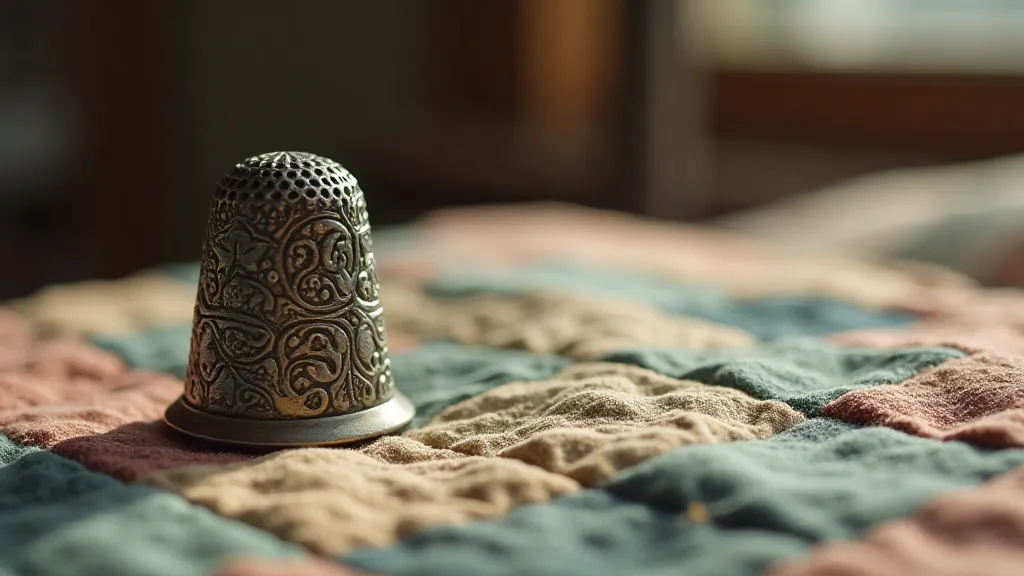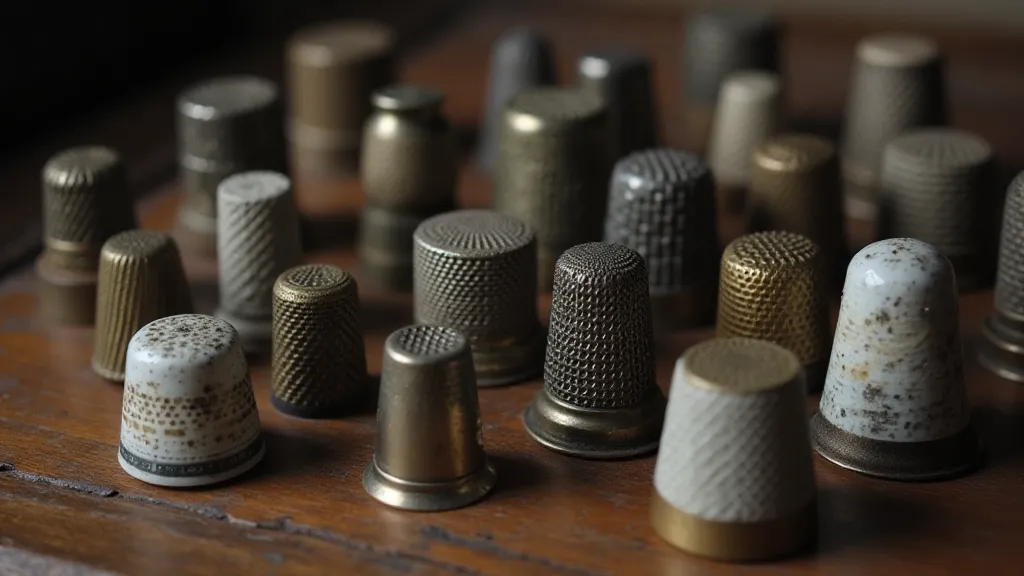Beyond the Material: Understanding the Intangible Value of Heirloom Thimbles
A tiny, often overlooked accessory – the thimble. We picture a simple tool, a protective shield for a seamstress's finger. And it is that. But to those who inherit them, to those who hold them in their hands and trace the worn edges with reverent fingers, a thimble can be so much more. It’s a connection to the past, a tangible echo of lives lived, and a poignant reminder of heritage. It’s an heirloom, often worth far more than its material composition could ever suggest.
My grandmother, Elsie, had a small tin box filled with thimbles. Not a vast collection, certainly, but each one felt significant. I remember, as a child, being fascinated by the glint of metal and the miniature landscapes of porcelain, silver, and sometimes, even what seemed like bits of precious stone. She's gone now, but the memory of her calloused hands guiding mine, patiently showing me how to sew a simple stitch, and the quiet dignity with which she held that small metal protector, remains vividly clear. That tin box, and the contents within, is more valuable to me than any sum of money could represent.
A Brief History: More Than Just Sewing
The history of the thimble stretches back centuries, evolving alongside the craft of sewing. Early versions weren't quite what we recognize today. Before the standardized metal thimbles we’re familiar with, seamstresses used a variety of methods to protect their fingers, including finger stalls made from leather, bone, or even nuts. The introduction of metal thimbles, particularly those made of brass and silver, began to gain traction in Europe during the 16th century. These early thimbles were often highly decorative, reflecting the wealth and status of the person using them. Think of the intricate floral designs, the crests and monograms painstakingly etched into the metal – these were not mere tools; they were status symbols, often passed down through generations. Consider, too, the societal forces at play – as domestic industries flourished, the very tools used became imbued with meaning, hinting at the narratives of the women who skillfully employed them; one could almost imagine the ghost of the seamstress, silently observing, her legacy preserved within the worn metal.
The industrial revolution brought about mass production, making thimbles more accessible and affordable. However, this didn’t diminish their significance. In fact, in many working-class families, a thimble was an essential possession, representing not just a tool but a symbol of independence and the ability to earn a living through skilled labor. They were a lifeline, a means of supporting families, and a legacy of perseverance. The transformation of base metals into these cherished heirlooms is a fascinating process, and those curious about the techniques and artistry involved might want to learn more about the alchemy of stitch.

The Craftsmanship Speaks Volumes
Look closely at an antique thimble, really *look*. Notice the weight of the metal, the precision of the design, the subtle imperfections that betray the hand that crafted it. Many older thimbles weren’t stamped out by machines. They were painstakingly formed from sheet metal, often hand-chased or engraved. The level of detail is astounding – miniature landscapes, portraits, intricate borders – all rendered in incredibly small scale. The skill and dedication required to produce such pieces is humbling. It’s fascinating to consider how artistic expression found its way into even the most utilitarian objects, like thimbles. The colors used, for instance, often carried symbolic weight; further investigation into the language of color in antique thimble decoration reveals a deeper layer of meaning.
Porcelain thimbles, often decorated with hand-painted scenes, add another layer of artistry. These weren’t just functional objects; they were miniature works of art. The delicate brushstrokes, the vibrant colors – they speak to a different kind of dedication and talent.
Sometimes, a thimble’s value isn’t purely monetary. It’s tied to the story it holds. A tiny chip in the rim might be from a dropped stitch, a faint scratch might be from a hasty repair during a late-night sewing session. These imperfections aren't flaws; they're badges of honor, evidence of a life lived, a purpose served.
More Than a Tool: Stories Woven Within
The true value of a family heirloom thimble rarely lies in its intrinsic worth. It’s the narrative it carries. Perhaps it belonged to a great-grandmother who emigrated from a distant land, using her sewing skills to build a new life. Maybe it was a gift from a beloved mother, a symbol of her pride in her daughter's burgeoning talents. Or perhaps it was simply a constant companion during long hours spent creating beautiful garments for loved ones.
Imagine a young woman during the Second World War, painstakingly mending uniforms for soldiers, her thimble a silent witness to her hopes and fears. Or picture a seamstress in a bustling Victorian workshop, her thimble protecting her fingers as she created elaborate gowns for the wealthy elite. Each thimble holds a universe of unspoken stories, of triumphs and hardships, of love and loss. It’s remarkable how these small objects can serve as poignant reminders of entire industries and the lives interwoven within them; one can almost perceive thimbles as relics of lost domestic industries, whispers of a past era.
The patterns used in these early creations, too, weren’t random; they reflected the tastes and trends of the time. To understand the evolution of these designs, one can trace the inspiration drawn from broader sewing patterns. The influence is evident - further exploration reveals glimpses through a loophole, showing how even thimble design was influenced by broader artistic movements.

Caring for Your Heirlooms: Gentle Preservation
While monetary value can fluctuate, the sentimental worth of an heirloom thimble remains constant. Gentle care is crucial to preserving these treasures for future generations. Avoid harsh chemicals or abrasive cleaning methods. A soft cloth and warm water are often sufficient to remove dirt and grime. For silver thimbles, a silver polishing cloth can help restore their luster, but be cautious not to remove any patina that contributes to their character. Patina, that subtle aging process, can actually enhance the beauty and historical significance of these pieces.
Storage is also important. Individual thimbles can be stored in small pouches or padded boxes to prevent scratches and damage. Avoid storing them in damp or humid environments, which can accelerate corrosion. Ultimately, the goal isn’t to make them look brand new; it's to protect them from further deterioration and ensure their longevity. The ongoing preservation of these objects ensures the stories they represent are passed onto generations to come.
Passing on the Legacy
The most important aspect of preserving a family heirloom thimble isn't just the physical object itself. It's the story behind it. Share the history, the memories, the connection to the past with younger generations. Let them hold the thimble, feel its weight, and imagine the hands that guided it before them. This is how we ensure that the legacy continues, that the stories are not forgotten, and that the true value of these tiny treasures endures. Perhaps a child, hearing the story of their ancestor’s thimble, will be inspired to learn a craft themselves, continuing the cycle of creativity and connection. Imagine the power of these objects to ignite a passion for history and artistry within a young mind.
A thimble might be a small thing, easily overlooked. But within its diminutive form lies a universe of history, craftsmanship, and heartfelt connection. It’s a tangible link to our past, a reminder of the lives that came before us, and a symbol of the enduring power of family and tradition. These seemingly insignificant tools hold within them echoes of lives lived, dreams pursued, and legacies forged.






